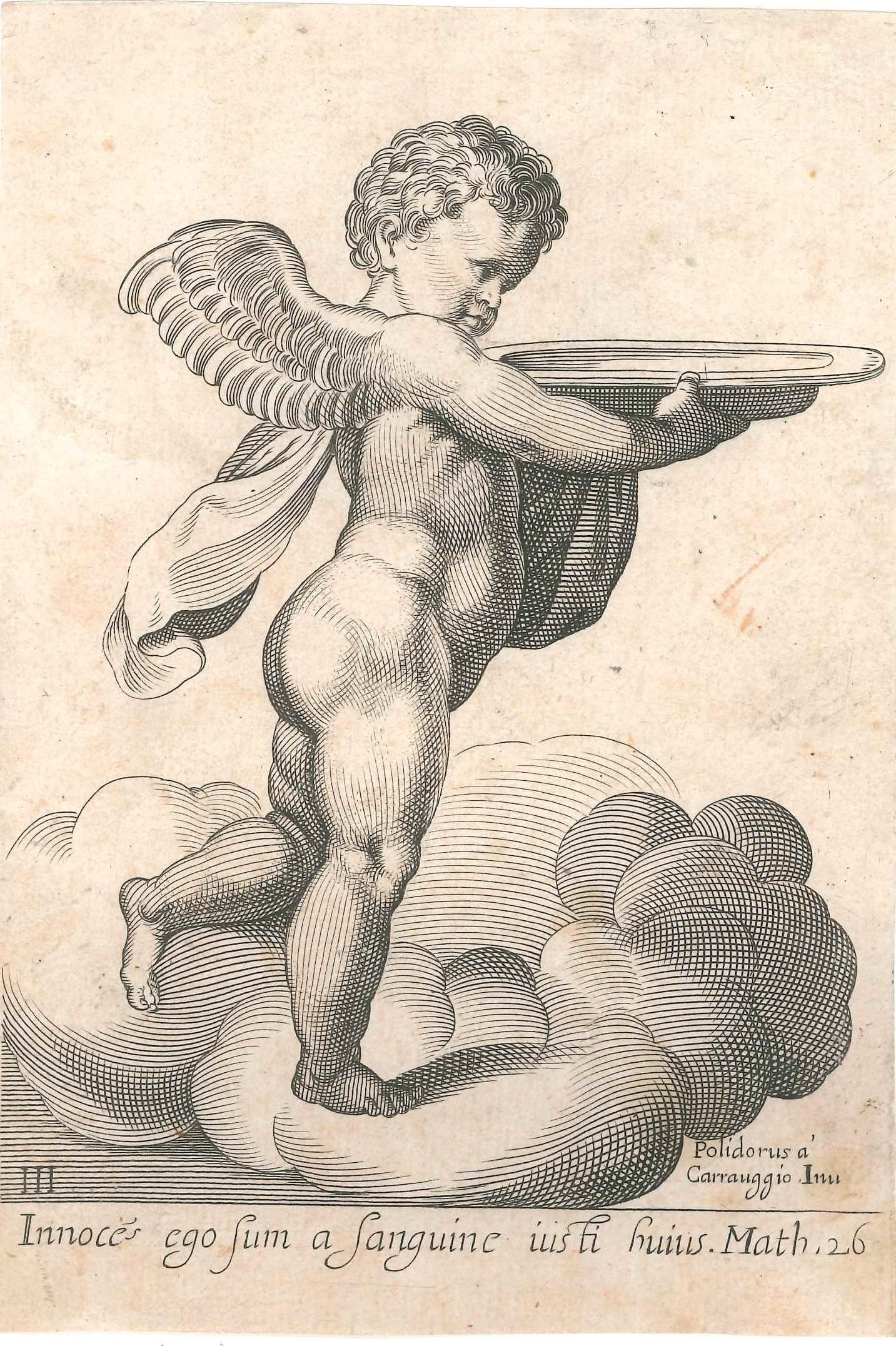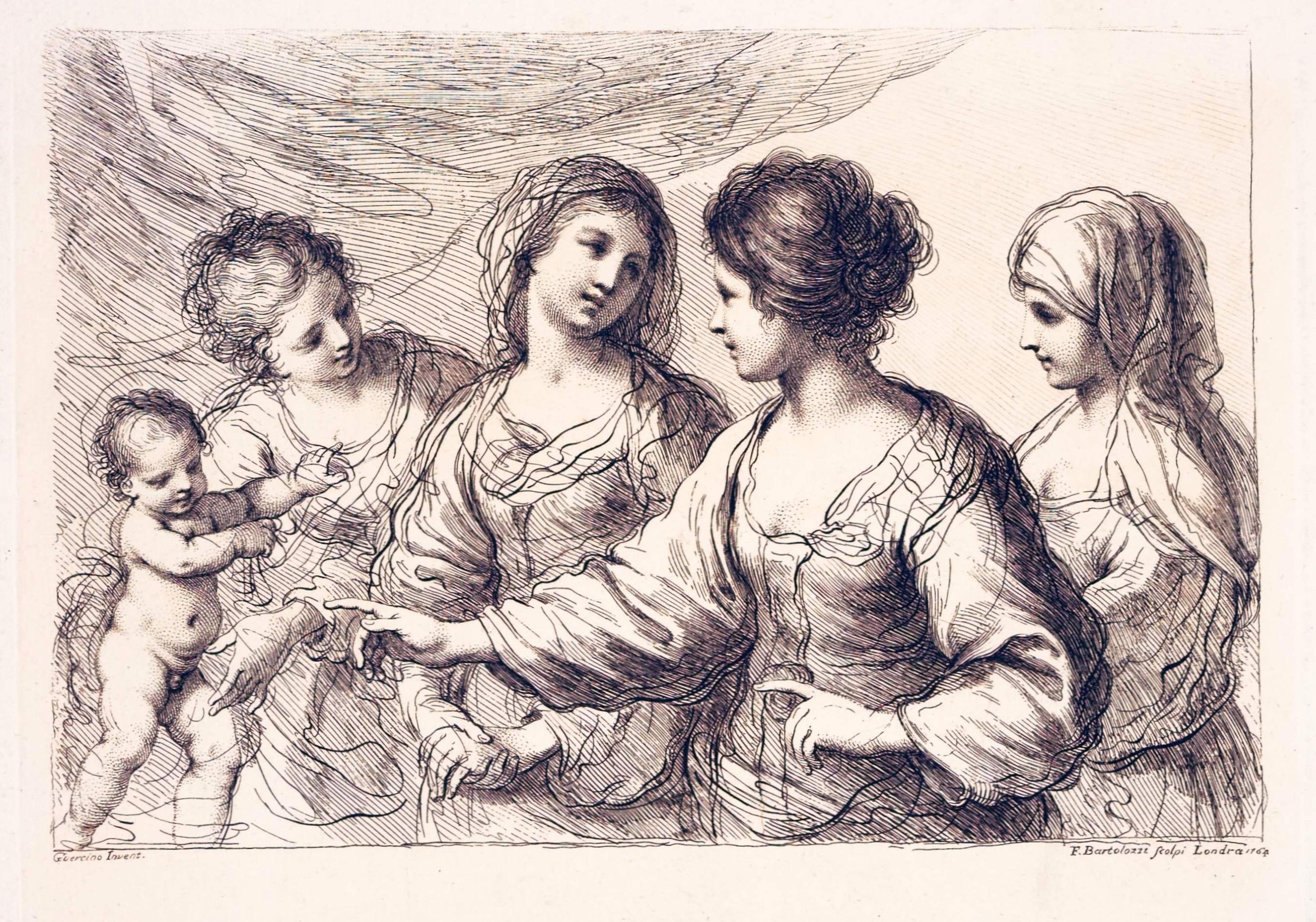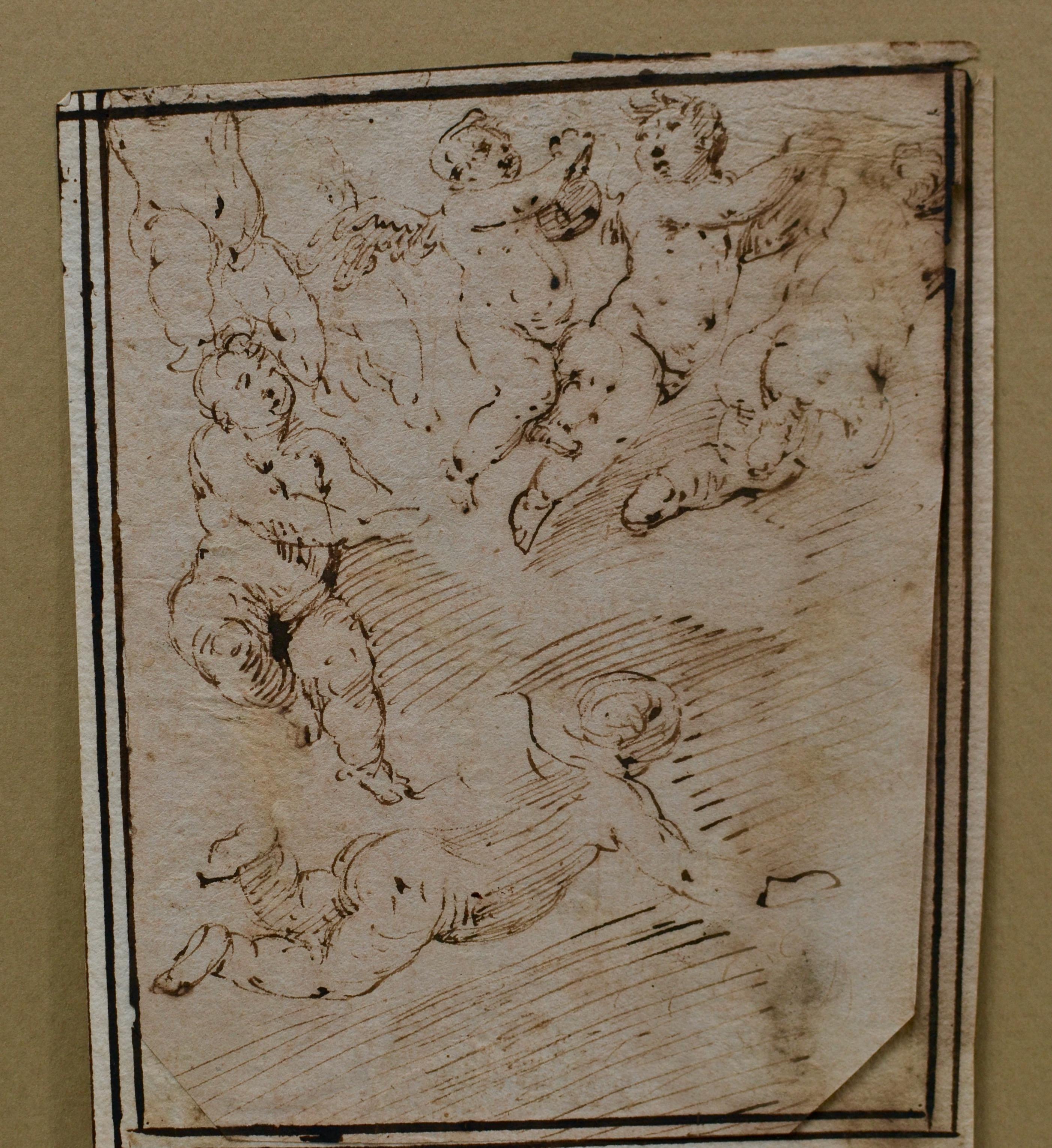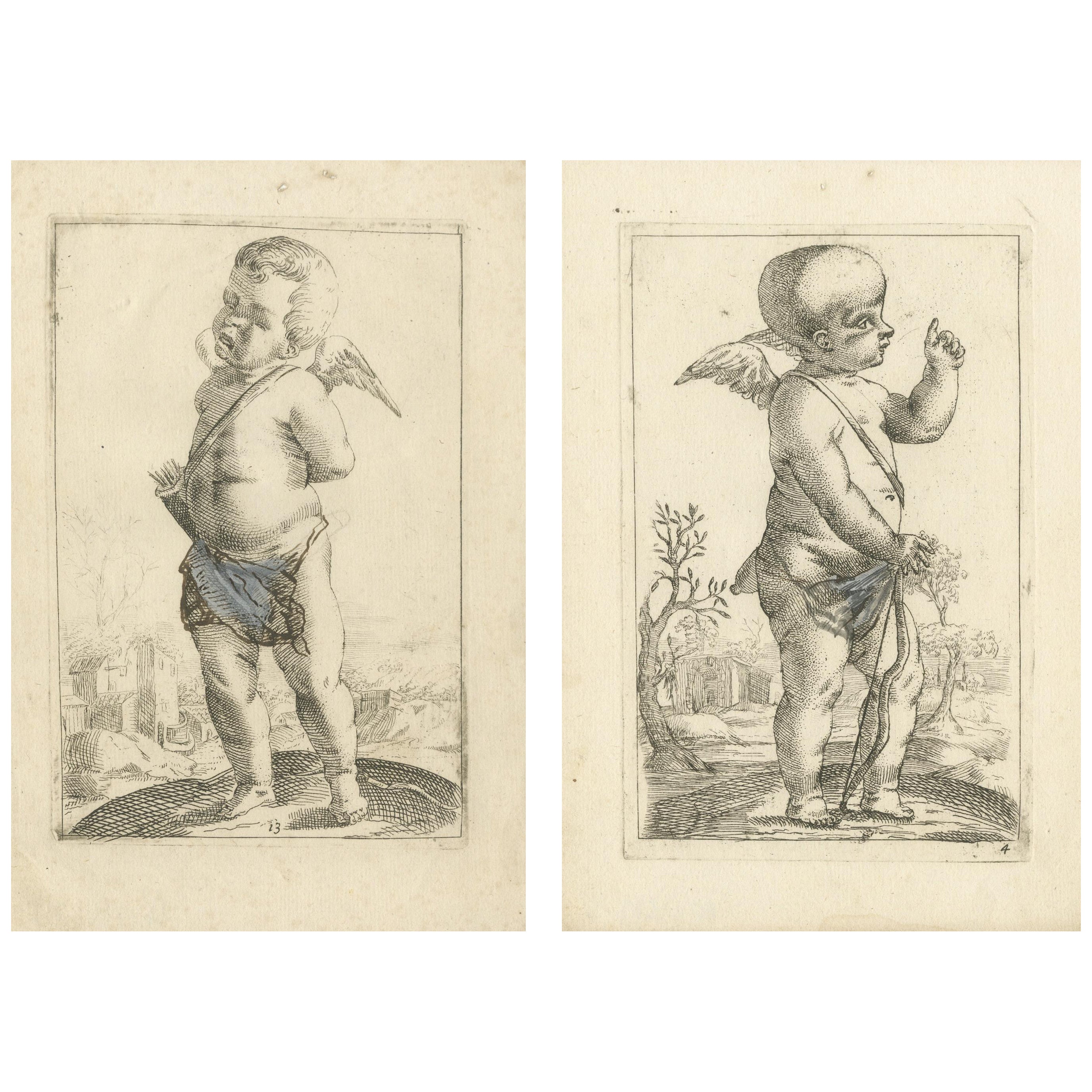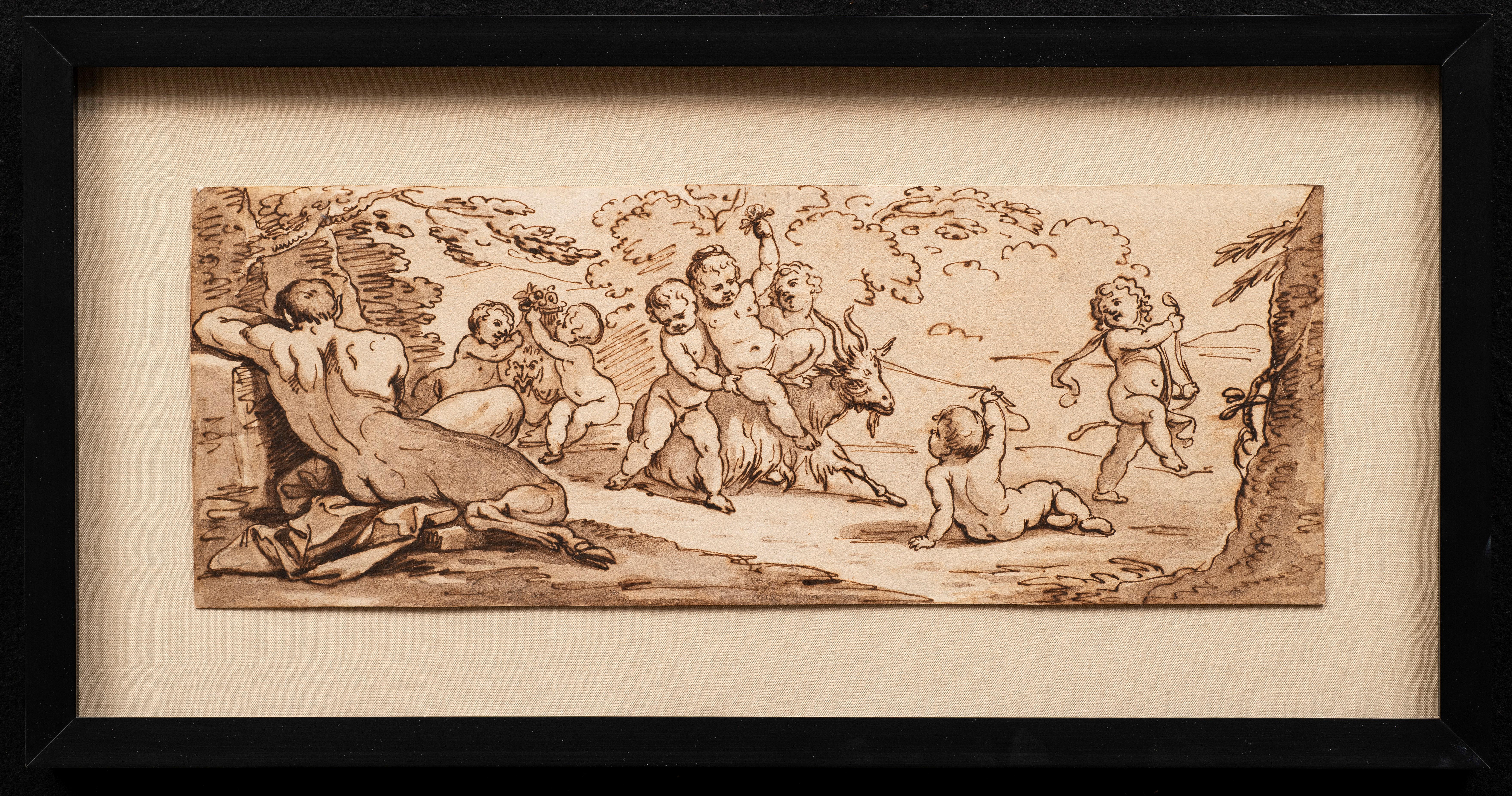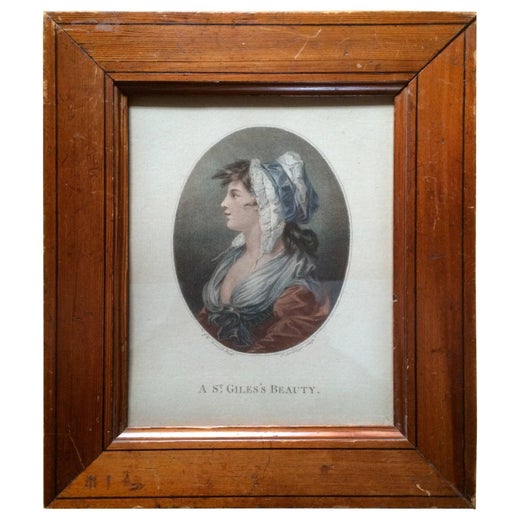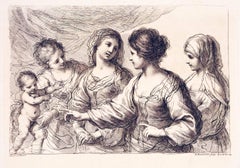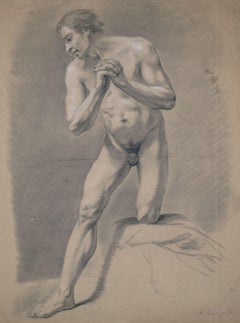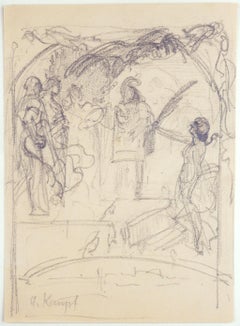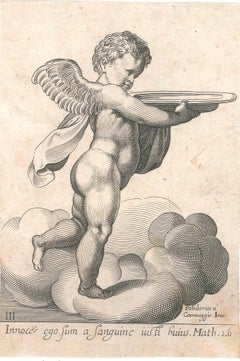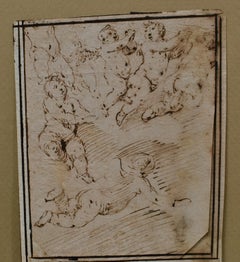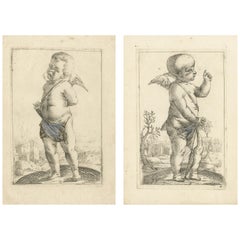Items Similar to Putti in an allegorical love game / - The Ambivalence of Eros -
Want more images or videos?
Request additional images or videos from the seller
1 of 8
Francesco BartolozziPutti in an allegorical love game / - The Ambivalence of Eros -1764
1764
$503.42
£376.59
€420
CA$693.10
A$758.52
CHF 400.81
MX$9,053.39
NOK 5,114.82
SEK 4,677.92
DKK 3,199.93
About the Item
Francesco Bartolozzi (1728 Florence - 1815 Lisbon), Putti in an allegorical love game, around 1764. Crayon engraving on laid paper after a drawing by Guercino, 21 cm x 29 cm (plate size), 38 cm x 56.5 cm (sheet size), marked lower left “Guercino inv.” as an engraving after Guercino and signed lower right “F. Bartolozzi sculp”.
- the wide margin with corner losses, smaller tears, slightly foxed and somewhat dusty, the strong and precise depiction in good condition
- The Ambivalence of Eros -
This sheet showcases the artist's renowned skill, which resulted in his invitation to London and his appointment as "Engraver to the King." Bartolozzi combines a free-flowing, linear design with partial dotting to give the print an unprecedented graphic-painterly effect. This effect corresponds to the emerging appreciation of drawing as a direct form of artistic expression.
On the left, a putto lifts a drapery to reveal a reclining putto, whose body emerges from the shadows. This scene could have been depicted by Titian or Rubens, except here, it is the putti performing this love play imitatively. On the opposite side is a group of three putti that could also have been taken from a painting by Titian or Rubens. One aims a love arrow at the main scene while another strikes water. This creates an ironic interplay between imitation and the depiction of love play, whose ambivalence contributes to the eros of the painting.
About the artist
The son of goldsmith Gaetano Bartolozzi, young Francesco received his first artistic training from his father. He then attended the Academy of Fine Arts in Florence, studied antiquities in Rome, and joined Joseph Wagner's studio in Venice in 1745. Bartolozzi produced numerous engravings based on drawings by Venetian artists for Wagner's art publishing house. These engravings were popular due to their high quality. After engraving drawings by Guercino for George III's librarian, Richard Dalton, Dalton invited Bartolozzi to London in 1764. Bartolozzi lived there for the rest of his life. Bartolozzi was admitted to the Society of Artists, appointed engraver to the king, and elected to the newly founded Royal Academy of Art in 1769. While in London, Bartolozzi acquired the newly discovered crayon technique, which made it possible to translate chalk and charcoal drawings into prints by dotting. This technique became known in England as the "red chalk manner." Bartolozzi further developed this technique by using stippling to create surface effects instead of line-oriented designs, known as "stippled work." He was able to translate painterly and graphic effects into prints with great virtuosity, making Bartolozzi the most popular and sought-after reproduction engraver of his time. Angelika Kauffmann, for example, who also worked in London, had her works engraved by Bartolozzi. In 1802, at the age of 75, Bartolozzi accepted a position as director of the Academy of Fine Arts in Lisbon, where he worked until his death.
GERMAN VERSION
Francesco Bartolozzi (1728 Florenz - 1815 Lissabon), Putten im allegorischen Liebesspiel, 1764. Crayon-Stich auf Bütten nach einer Zeichnung von Guercino, 21 cm x 29 cm (Plattengröße), 38 cm x 56,5 cm (Blattgröße), unten links mit „Guercino inv.“ als Stich nach Guercino ausgewiesen und unten rechts mit „F. Bartolozzi sculp“ signiert.
- der breite Rand mit Eckverlusten, kleineren Einrissen, leicht stockfleckig und etwas angestaubt, die kräftig-präzise Darstellung in gutem Zustand
- Die Ambivalenz des Eros -
Das Blatt veranschaulicht die gefeierte Virtuosität des Künstlers, die zum Ruf nach London und seiner Ernennung zum „Engraver of the King“ geführt hat. Bartolozzi verbindet hier eine frei-flüssige lineare Gestaltung mit einer partiellen Punktierung, so dass die Druckgrafik eine bisher nicht gesehene zeichnerisch-malerische Wirkung erhält, was der damals einsetzenden Schätzung der Zeichnung als unmittelbarem künstlerischen Ausdruck entspricht.
Links hebt ein Putto eine Draperie an und enthüllt einen liegend posierenden Putto, dessen Körper aus dem Schatten heraus sichtbar wird. Eine Szene wie sie auch von Tizian oder Rubens dargestellt worden sein könnte, nur dass es hier Putten sind, die dieses Liebesspiel auf nachahmende Weise vollführen. Gegenüber steht eine Gruppe von drei Putten, die ebenfalls einem Gemälde von Tizian oder Rubens entnommen sein könnten. Einer von ihnen zielt mit einem Liebespfeil auf die Hauptszenerie, während der andere ‚Wasser schlägt‘. Ein ironisches Wechselspiel zwischen Nachahmung und Aufzeigen der Natur des Liebesspiels, das n seiner Ambivalenz zum Eros des Bildes beiträgt.
zum Künstler
Als Sohn des Goldschmieds Gaetano Bartolozzi erhielt der junge Francesco bei seinem Vater eine erste künstlerische Ausbildung. Anschließend besuchte er die Florentiner Kunstakademie, hielt sich zum Antikenstudium in Rom auf und ging dann nach Venedig, wo er 1745 in das Atelier Joseph Wagners eintrat. Für dessen Kunstverlag fertigte Bartolozzi zahlreiche Stiche nach Zeichnungen venezianischer Künstler an, die sich aufgrund ihrer kongenialen Umsetzung großer Beliebtheit erfreuten. Nachdem er für den Bibliothekar George III., Richard Dalton, Zeichnungen von Guercino gestochen hatte, lud ihn dieser 1764 nach London ein, wo Bartolozzi fortan ansässig war. Er wurde in die Society of Artists aufgenommen, zum Kupferstecher des Königs ernannt und 1769 in die neugegründete Königliche Kunstakademie gewählt. In London eignete er sich die neuerfundene Punktier- oder Crayon-Manier an, die es erlaubt, durch Punktierungen Kreide- und Kohlezeichnungen in die Druckgrafik zu übersetzen, weshalb sie in England auch unter dem Namen ‚Red Chalk Manner‘ bekannt geworden ist. Bartolozzi entwickelte diese Technik weiter, indem er statt einer linienorientierten Gestaltung durch Punktierungen Flächenwirkungen erzeugte, was als ‚Stippled Work‘ bezeichnet wurde. Auf diese Weise vermochte er sowohl malerische wie zeichnerische Wirkungen druckgrafisch umzusetzen, was er mit höchster Virtuosität beherrschte, so dass Bartolozzi zum beliebtesten und gefragtesten Reproduktionsstecher seiner Zeit wurde. So ließ beispielsweise Angelika Kauffmann, die ebenfalls in London tätig war, ihre Werke von Bartolozzi stechen. Im Alter von 75 Jahren folgte er, 1802, dem Ruf nach Lissabon, wo Bartolozzi bis zu seinem Tode als Direktor der Kunstakademie wirkte.
- Creator:Francesco Bartolozzi (1727-1815, Italian)
- Creation Year:1764
- Dimensions:Height: 14.97 in (38 cm)Width: 22.05 in (56 cm)Depth: 0.4 in (1 cm)
- Medium:
- Movement & Style:
- Period:1760-1769
- Condition:
- Gallery Location:Berlin, DE
- Reference Number:1stDibs: LU2438216392712
Francesco Bartolozzi
The son of goldsmith Gaetano Bartolozzi, young Francesco received his first artistic training from his father. He then attended the Academy of Fine Arts in Florence, studied antiquities in Rome, and joined Joseph Wagner's studio in Venice in 1745. Bartolozzi produced numerous engravings based on drawings by Venetian artists for Wagner's art publishing house. These engravings were popular due to their high quality. After engraving drawings by Guercino for George III's librarian, Richard Dalton, Dalton invited Bartolozzi to London in 1764. Bartolozzi lived there for the rest of his life. Bartolozzi was admitted to the Society of Artists, appointed engraver to the king, and elected to the newly founded Royal Academy of Art in 1769. While in London, Bartolozzi acquired the newly discovered crayon technique, which made it possible to translate chalk and charcoal drawings into prints by dotting. This technique became known in England as the "red chalk manner." Bartolozzi further developed this technique by using stippling to create surface effects instead of line-oriented designs, known as "stippled work." He was able to translate painterly and graphic effects into prints with great virtuosity, making Bartolozzi the most popular and sought-after reproduction engraver of his time. Angelika Kauffmann, for example, who also worked in London, had her works engraved by Bartolozzi. In 1802, at the age of 75, Bartolozzi accepted a position as director of the Academy of Fine Arts in Lisbon, where he worked until his death.
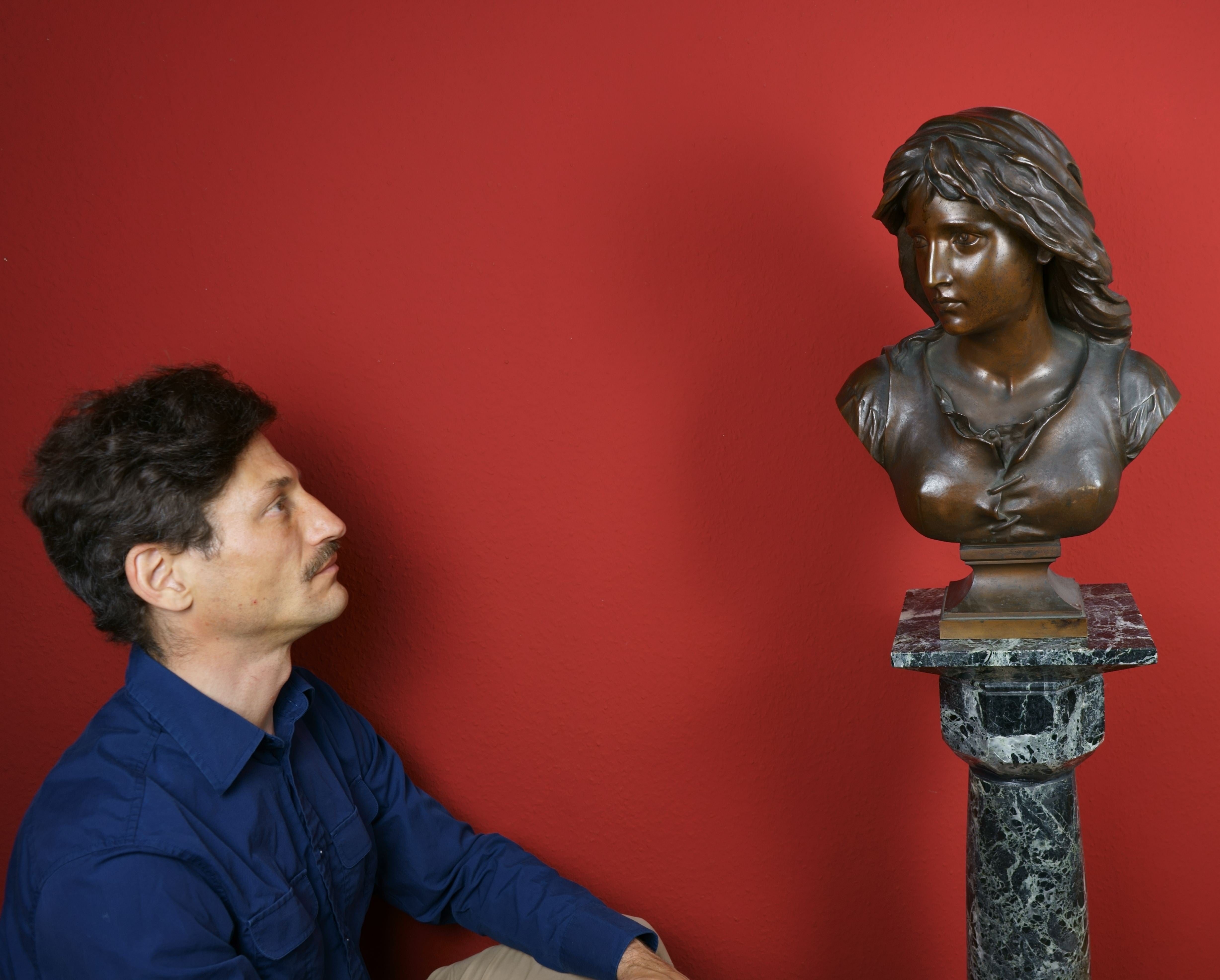
About the Seller
5.0
Vetted Professional Seller
Every seller passes strict standards for authenticity and reliability
Established in 2014
1stDibs seller since 2023
23 sales on 1stDibs
- ShippingRetrieving quote...Shipping from: Berlin, Germany
- Return Policy
More From This Seller
View AllFour Young Women and the Boy Cupid / - Mysterious Virtuosity -
By Francesco Bartolozzi
Located in Berlin, DE
Francesco Bartolozzi (1728 Florence - 1815 Lisbon), Mythological Scene with Four Young Women and the Boy Cupid, 1764. Crayon engraving on laid paper after a drawing by Guercino, 22 c...
Category
1760s Realist Figurative Prints
Materials
Paper
Male Nude / - The Drama of the Nude -
Located in Berlin, DE
Johann Heinrich Meil (1730 Gotha - 1820 Berlin), Male Nude, 1807. White heightened, occasionally wiped charcoal drawing on brownish paper, 51 cm x 39.5 cm, signed “J.[ohann] H.[einri...
Category
Early 19th Century Rococo Nude Drawings and Watercolors
Materials
Paper
Study for an allegory of victory / - A virtuoso victory -
By Arthur Kampf
Located in Berlin, DE
Arthur Kampf (1864 Aachen - 1950 Castorp-Rauxel), Study to an allegory of victory, around 1900. Pencil on paper, 21 cm x 18 cm, signed lower left "A. Kampf".
- slightly darkened, otherwise in good condition
- A virtuoso victory -
About the artwork
The vertical-format sketch illustrates a plateau to which a staircase leads up from the right. Arthur Kampf thus takes up a typical baroque disposition for the depiction of allegories. And indeed, a female figure climbs the steps to hand the palm of victory to a figure that is probably also female. Other persons standing on the plateau pay homage to her, whereby the figure on the left edge of the picture may represent a warrior.
The scene is framed by an ornamentally decorated arch field, which additionally emphasizes the allegorical-historical content of the depiction. An arch can also be seen under the staircase, suggesting that this may be a design for a supraport.
The sheet could have been created in the wake of Arthur Kampf's appointment in 1899 as head of the studio for history painting at the Berlin Art Academy. The drawing style, which only outlines the idea of the picture and yet is determined by concise lines, corresponds to the sketchiness of the Baroque and testifies to Arthur Kampfs intensive study of this heyday of history painting.
About the artist
Arthur Kampf was the son of the Aachen painter and imperial court photographer August Kampf. His older brother Eugen and his son Herbert were also painters.
Arthur Kampf studied at the Düsseldorf Academy of Art from 1879 under Eduard von Gebhardt and Peter Janssen the Elder, whose master pupil he was from 1883 to 1891. Influenced by the naturalistic paintings of Jules Bastien-Lepage, which Kampf saw on a trip to Paris in 1885, he created the painting "The Last Statement" in 1886, which was based on a personal experience. It shows a man mortally wounded by knife wounds. The oppressive drasticness of the almost life-size depiction caused a sensation and controversial criticism.
The first successes were achieved: At the Berlin Jubilee Exhibition of 1886, Kampf received an honorable mention, and at the Munich Annual Exhibition of 1890, he was awarded a gold medal. Between 1886 and 1936, Kampf participated in all the major German exhibitions.
In 1887 the artist painted his first fresco, which was the beginning of a series of monumental compositions. With the highly successful painting "The Burial of the Corpse of Kaiser Wilhelm I in the Berlin Cathedral" (1888), Kampf established himself as a painter of contemporary history, following in the footsteps of Adolph von Menzel, whose oeuvre he immediately took up with the painting "Speech by Frederick the Great to His Generals in Koeben" (1893). The pictures of his Liberation War cycle were included in school textbooks and distributed in large editions as postcards.
As for his academic career, Kampf became an assistant professor at the Düsseldorf Academy of Art in 1887, and in 1894 he was appointed professor of the class for antiquities and nature, and in 1897 he became head of the painting class. In 1899 Kampf was appointed director of the history painting studio at the Berlin Academy of Art. In 1901 he became a full member of the academy and was its president from 1907 to 1912. As Anton von Werner's successor, Kampf directed the Academy of Fine Arts in Charlottenburg from 1915 to 1925.
Among his monumental works is the painting of the assembly hall of the Aachen town hall, done between 1898 and 1902. It focuses on the social welfare of the state and the work of the people. Important subsequent commissions include the painting of the reading room of the new Royal Library in Berlin and the new auditorium of the University of Berlin with "Fichte's Speech to the German Nation". During World War I, at the request of General Ewald von Lochow, Kampf traveled to the Western theaters of war, including Warsaw in 1916.
In addition to painting, Kampf was also intensively involved in printmaking and, together with his brother Eugen and artist friends such as Alexander Frenz and Olof Jernberg, was considered an innovator of lithography in Düsseldorf. From 1913 on, he worked continuously as an illustrator of historical works and literary classics such as Shakespeare and Goethe.
Kampf remained a recognized artist after 1933. On the occasion of the retrospective of his complete works at the "Great German Art Exhibition", he was awarded the "Eagle Shield of the German Reich". During the final phase of World War II, Kampf was placed on Hitler's "Gottbegnadetenliste," which protected him from military service. After World War II, Kampf, whose work was largely destroyed, fell into obscurity.
Arthur Kampf belonged to numerous artists' associations. He was a member of the "Rheinisch-Westfälischer Künstlerbund", the "Society of German Watercolorists", the "Association of German Illustrators", the "Malkasten", the "Künstlerclub St. Lucas", the "Düsseldorfer Künstlerbund", the "Freie Vereinigung Düsseldorfer Künstler" and the "Berliner Künstlerbund".
Arthur Kampf's sister was married to the painter Alexander Frenz.
"Kampf's public recognition in the German Empire later led to his being one-sidedly labeled as a history painter and representative of the Wilhelmine era. This classification does not do justice to the artist's oeuvre as a whole. His early talent did not experience a rapid development later on, but it reached an ever greater mastery in the sense of an impressively relaxed realism and extended thematically beyond history. Kampf was also an excellent draughtsman, etcher and lithographer. Many of his works have been destroyed or lost, and some lead a shadowy existence in museum storerooms."
- Otto Zirk
"His importance as a Wilhelminian painter and cultural politician has been forgotten in favor of an exaggerated reception of his work during the Third Reich.
- Andreas Schroyen
Selection of public collections that own works by Arthur Kampf:
Altonaer Museum Hamburg, Berlinische Galerie, Burg Frankenberg Aachen, Busch-Reisinger Museum Cambridge/Mass., Deutsches Historisches Museum Berlin, Government Art Collection London, Kulturhistorisches Museum Magdeburg, Kunsthalle Hamburg, Museum für Kunst- und Kulturgeschichte Dortmund, Museum Kunstpalast Düsseldorf, Neue Nationalgalerie Berlin, Suermondt-Ludwig-Museum Aachen, Van der Heydt-Museum Wuppertal.
Selected Bibliography
Hans W...
Category
Early 20th Century Realist Figurative Drawings and Watercolors
Materials
Paper
The completely naked prostration
Located in Berlin, DE
Willibrord Haas (*1936 Schramberg), The completely naked prostration, 1999. Etching, 32.5 cm x 23.5 cm (plate size), 54 cm x 37.5 cm (sheet size). Signed “Willibrord Haas” in lead by...
Category
1990s Realist Nude Prints
Materials
Paper
Access
Located in Berlin, DE
Willibrord Haas (*1936 Schramberg), Access, 1979. etching, 40 cm x 30 cm (plate size), 54 cm x 37.5 cm (sheet size). Signed “Willibrord Haas” in pencil by the artist, dated “1979”, t...
Category
1970s Realist Nude Prints
Materials
Paper
Intertwined Figures - Complementary tension -
Located in Berlin, DE
Johanna Obermüller (*1938 Timișoara), Intertwined Figures, around 1985. Pigment print on Japanese paper, 25 cm x 33.5 cm (image), 29.8 cm x 42.5 cm (sheet dimensions), signed “Johann...
Category
1980s Contemporary Figurative Prints
Materials
Paper
You May Also Like
Putto - Original Etching after Polidoro da Caravaggio - 17th Century
Located in Roma, IT
Putto is an original black and white etching, after Polidoro da Caravaggio, realized by Giovanni Battista Galestruzzi during XVII century. Latin...
Category
17th Century Figurative Prints
Materials
Etching
Italian School 17th Century Drawing of Putti
Located in Stockholm, SE
A fine small Italian 17th/18th century sepia ink study of 6 putti in different positions. Paper mounted on paper. A tergo written "Scuola Lombarda".
A putto/putti are figure in a wo...
Category
17th Century Italian School Figurative Drawings and Watercolors
Materials
Ink
Baroque Putti: Serenade of Innocence and Play, circa 1620
Located in Langweer, NL
These images are rare but fine examples of original 17th-century European engravings, displaying characteristics that might point to an Italian origin based on stylistic analysis. Th...
Category
Antique 1620s Prints
Materials
Paper
Putti in a Landscape, Putti playing, flowers, Berchet, French Art, Old Master
By Pierre Berchet
Located in Greven, DE
Pierre Berchet, Drawing of Putti playing in a landscape,
Painter of decorative history subjects; trained under La Fosse; worked in France and during the 1690s...
Category
17th Century Baroque Figurative Drawings and Watercolors
Materials
Handmade Paper
$1,726 Sale Price
20% Off
Antique Italian School Late 17th - Early 18th "Cherubs (A)" Pen drawing of Putti
Located in SANTA FE, NM
"Cherubs" (A)
Pen and Ink drawing of Putto
Italian School
Late 17th early 18th century.
Pen and ink on paper
6 ½ x 17 ½ (22 ½ x 11 ½) inches
Antique scenes of putto and a faun cele...
Category
Late 17th Century Old Masters Figurative Paintings
Materials
Paper, Ink, Pen
'Cherubs Playing', Angels, Amorini, Memento Mori, Naive, Baroque Religious Oil
Located in Santa Cruz, CA
An early eighteenth-century, Italian baroque figural oil showing a group of cherubs or Amorini grouped together before red velvet drapes, one reclining on a wooden cross and wearing ...
Category
Early 18th Century Baroque Figurative Paintings
Materials
Canvas, Oil, Board
